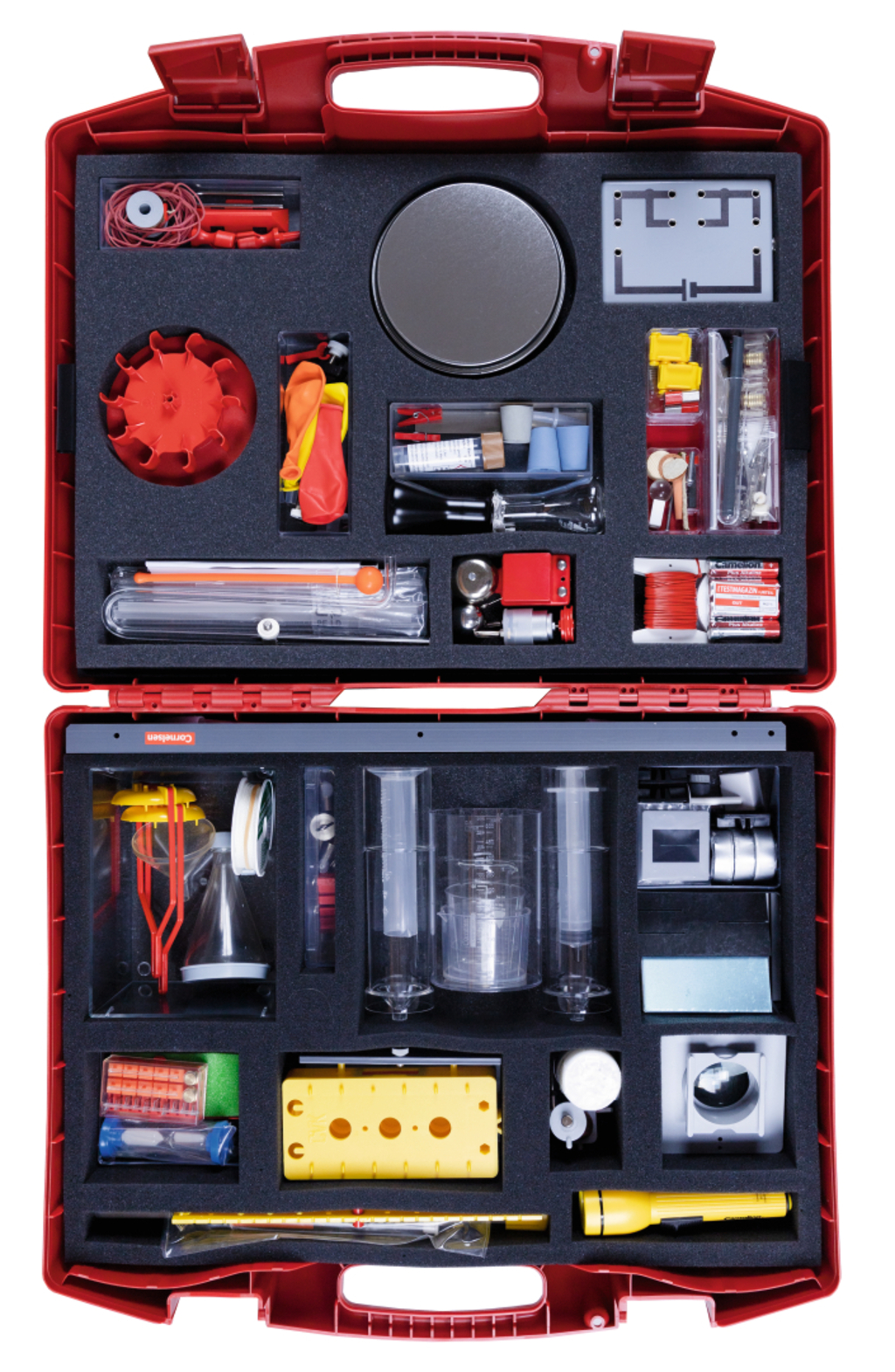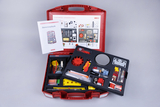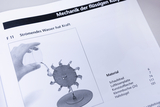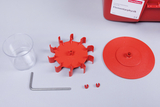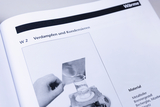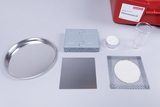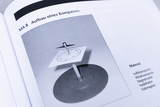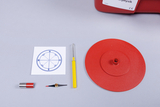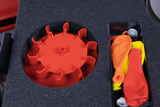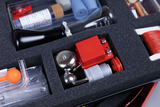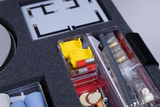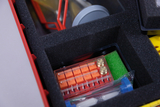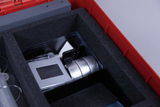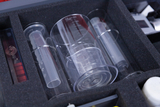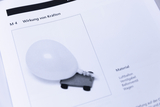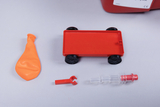Students kit Fundamental physics
The equipment in this kit makes it possible to conduct 96 fundamental experiments on the topics of mechanics, energy, heat, acoustics, optics and electricity. The key focus is on understanding the effects of physical laws and the precise
measurement of physical quantities.
The selection of individual components has been made under the consideration that they can be used in as many functions as possible.
The experiments can be set up with the help of the clear experiment instructions in such a way that they are guaranteed to function properly.
No additional materials or equipment are necessary. The equipment in the kit can also be used outside a laboratory.
Detailed instructions for 96 experiments for the following topics:
• Mechanics of solid bodies / 17 Experiments
• Mechanics of fluids / 11 Experiments
• Mechanics of gases / 10 Experiments
• Heat / 9 Experiments
• Sound / 5 Experiments
• Light / 16 Experiments
• Magnetism / 8 Experiments
• Electricity / 20 Experiments
Technical specifications
Size of kit: 540 x 450 x 150 mm
The students determine the volume of a solid.
This experiment examines force measurement.
The students measure the pendulum oscillations using a homemade pendulum.
Using a balloon, balloon valve, trolley and valve fork, students can investigate the effect of forces.
The students observe the inertia of the mass with the help of a steel ball.
How does a two-sided lever work? With the help of a profile rail, a balance and a force gauge, the students can investigate and find out.
This experiment shows how a spring force gauge works and the relationship between the mass of a body and the force exerted.
A beam balance can be used to compare an unknown mass of a body with a known mass of a weight.
The students build a running weight scale and learn the difference to a beam scale.
In this experiment, the students investigate the properties of the fixed roller.
In this experiment, the principle of the pulley is investigated.
How does the water level in a beaker behave if you tilt it sideways a little?
Two filter tubes are connected to each other and filled with liquid. The students observe what happens when they are stationary and what happens when a filter tube is lowered.
What happens when you fill a beaker with liquid and immerse a capillary tube vertically?
We will shortly provide you with a description of the experiment at this point.
The students investigate the pressure distribution in liquids using a suction bottle and a hose.
In this experiment, pressure is applied to a liquid that is in an enclosed space.
Students investigate the buoyancy of liquids by immersing them in water.
In this experiment, students learn about Archimedes' law.
Using an Erlenmeyer flask, students investigate swimming, floating, and sinking.
Using a paddle wheel, students can observe that water has power.
This experiment shows that air is a body.
This experiment investigates the fact that trapped air can be compressed, but can also expand.
The students build a U-tube manometer and observe the water column when pressure is applied in a suction bottle.
What happens when gases heat up or cool down? In this experiment, the students can immediately observe the changes in volume when a gas heats up and cools down.
This experiment shows the positive and negative pressure of the trapped air in the U-tube.
In this experiment, a suction bottle with a funnel is placed in a tub filled with water. Air is now pulled out with the help of a syringe. The students observe what happens now and learn how a suction hook works.
The students learn about the model of a spray bottle.
In this experiment, a balloon is filled with air using a balloon valve and placed on an air cushion plate. The students observe what happens when the valve is opened.
An inflated balloon is held over a paddle wheel with the balloon valve. The valve is then opened and the students observe the paddle wheel.
We will shortly provide you with a description of the experiment at this point.
We will shortly provide you with a description of the experiment at this point.
We will shortly provide you with a description of the experiment at this point.
We will shortly provide you with a description of the experiment at this point.
We will shortly provide you with a description of the experiment at this point.
We will shortly provide you with a description of the experiment at this point.
We will shortly provide you with a description of the experiment at this point.
We will shortly provide you with a description of the experiment at this point.
We will shortly provide you with a description of the experiment at this point.
We will shortly provide you with a description of the experiment at this point.
We will shortly provide you with a description of the experiment at this point.
We will shortly provide you with a description of the experiment at this point.
We will shortly provide you with a description of the experiment at this point.
We will shortly provide you with a description of the experiment at this point.
We will shortly provide you with a description of the experiment at this point.
We will shortly provide you with a description of the experiment at this point.
We will shortly provide you with a description of the experiment at this point.
We will shortly provide you with a description of the experiment at this point.
We will shortly provide you with a description of the experiment at this point.
We will shortly provide you with a description of the experiment at this point.
We will shortly provide you with a description of the experiment at this point.
We will shortly provide you with a description of the experiment at this point.
We will shortly provide you with a description of the experiment at this point.
We will shortly provide you with a description of the experiment at this point.
We will shortly provide you with a description of the experiment at this point.
We will shortly provide you with a description of the experiment at this point.
We will shortly provide you with a description of the experiment at this point.
We will shortly provide you with a description of the experiment at this point.
We will shortly provide you with a description of the experiment at this point.
We will shortly provide you with a description of the experiment at this point.
We will shortly provide you with a description of the experiment at this point.
We will shortly provide you with a description of the experiment at this point.
We will shortly provide you with a description of the experiment at this point.
We will shortly provide you with a description of the experiment at this point.
We will shortly provide you with a description of the experiment at this point.
We will shortly provide you with a description of the experiment at this point.
We will shortly provide you with a description of the experiment at this point.
We will shortly provide you with a description of the experiment at this point.
We will shortly provide you with a description of the experiment at this point.
We will shortly provide you with a description of the experiment at this point.
We will shortly provide you with a description of the experiment at this point.
We will shortly provide you with a description of the experiment at this point.
We will shortly provide you with a description of the experiment at this point.
We will shortly provide you with a description of the experiment at this point.
We will shortly provide you with a description of the experiment at this point.
We will shortly provide you with a description of the experiment at this point.
This experiment investigates the stability and center of gravity of a body.
With the help of a profile rail, a trolley and a force gauge, the students can investigate and find out about friction.
How does a one-sided lever work? With the help of a profile rail, a trolley and a dynamometer, the students can investigate and find out.
In this experiment, the students observe the center of gravity using a homemade cardboard body.
In this experiment, the students investigate the properties of the loose roll.
A force is required to pull a body upwards on an inclined plane. In this experiment, the students find out why this is the case.
In this experiment, the surface tension between the water surface and the underside of an air cushion plate is investigated.
What happens if you put a plastic plate on top of a cup filled with water, turn them both over, and then lift them up?
We will shortly provide you with a description of the experiment at this point.
We will shortly provide you with a description of the experiment at this point.
We will shortly provide you with a description of the experiment at this point.
We will shortly provide you with a description of the experiment at this point.
We will shortly provide you with a description of the experiment at this point.
We will shortly provide you with a description of the experiment at this point.
We will shortly provide you with a description of the experiment at this point.
We will shortly provide you with a description of the experiment at this point.
We will shortly provide you with a description of the experiment at this point.
We will shortly provide you with a description of the experiment at this point.
We will shortly provide you with a description of the experiment at this point.
We will shortly provide you with a description of the experiment at this point.
- 2 × Magnet rod, AlNiCo, 23 mmwith red-marked northpole
- 1 × Colouring agent, blue
- 2 × Plastic box, clear, 60/40
- 1 × Air cushion disc with bore 8/6 mm
- 1 × Lever with three bores and clamp socket
- 1 × Ball, steel, 25 mmØ
- 1 × Foam insert 1 for 16005, 505x355x35 mm
- 1 × Foam insert 2 for 16005, 515x350x85 mm
- 1 × Storing diagram,int.vers.(Fundamental Physics)
- 1 × Friction pad (foam) 95/45/10 mm
- 1 × Plastic-bar with hole
- 1 × Pencil lead 3 mm
- 1 × Lidfoam grey,515x355x10mm
- 1 × Tuning fork, 95 mm long not tuned
- 1 × Plastic case ca.540x450x150 mm
- 2 × Cord stretcher
- 1 × Triangular bridge
- 1 × Flexible hearing tubing 630 mm
- 1 × Metal plate, 150 mmØ
- 1 × U-shaped tube, perspex
- 1 × °Sifter with iron powder
- 1 × Beaker, plastic, 100 ml
- 1 ×
- 1 × Dynamometer, 1 N
- 1 × Tubing coupling
- 1 × Spring 100 mm / 12 N
- 1 × Heating wire , covered, 0,20 mm Ø (20 m)
- 1 ×
- 1 × Needle support with cap
- 1 × Clamp, 14 mm Ø with notch
- 1 × Clamp, 25 mm Ø with notch
- 1 × Coil with core on 4mm- plugs
- 1 × Beaker w. punctured base
- 1 × Slide holder
- 2 ×
- 1 × Mounting bracket
- 1 × Measuring cylinder, PP, 25 ml
- 1 × Thermometer, student type–25 to +50°C
- 1 × Rubber stopper 24/19 mm
- 1 × Friction rubber, wool
- 1 ×
- 1 ×
- 2 × Rubber stopper 24/18 mm with bore 6 mm
- 1 × Glass tube, straight, 200 mm
- 1 × Bimetallic strip
- 2 × Filter tube, transparent
- 1 × Connecting tubing, 300x14 mmØ
- 1 × Plastic test tube, 100 mm
- 1 × Pith ball pendulum
- 1 × Heat protection gauze
- 1 × Sand timer, 1 minute
- 1 × Plastic mallet, 160 mm (drum stick)
- 1 × Paddle wheel
- 1 × Needle support with plug
- 1 × Erlenmeyer flask 25 ml, black
- 2 × Crocodile clip with 4 mm plug
- 1 × Bulb,MES, 2,5V/0,1A clearset of 10 pcs.
- 1 × Floating disc, styrofoam,60 mmØ f.magnetic rod
- 1 × Trough, plastic 173 x 132 x 70 mm
- 1 × Suction flask 90 ml
- 1 × Funnel for the suction flask 47563, 60 mm ø
- 1 × Esbit burner, nickelplate
- 1 ×
- 1 ×
- 1 × Silicone tubing, 7/1,5 mmper m
- 1 × Screen translucent, plastic 90x90x1 mm
- 1 × Screen white, plastic 90x90x1 mm
- 1 × Bulb, MES, 4 V/1 A clear set of 10 pcs.
- 2 × Plastic box 140/50/35 mm
- 1 × Shadow rod
- 1 × Projection box, black
- 1 × Slit diaphragm 2/1
- 1 × Torch for 2 x R6
- 1 × Holding clip, 20 mm Ø, with notch
- 1 × Metal axis, 125 mm
- 1 × Mirror, plane, glass 90x90x2 mm
- 1 × Lens in frame f = +50 mm (biconvex)
- 1 × Lens in frame f = +100 mm(biconvex)
- 1 × Slide with arrow motif
- 2 ×
- 1 ×
- 1 × Cuvette
- 1 ×
- 3 ×
- 2 ×
- 1 × Set of weights (in box)
- 1 × Rail profile, 495 mm with bores
- 1 × Syringe with nozzle, 30 ml
- 1 × Clamp, 8 mm Ø with notch
- 1 × Angled stand base
- 1 × Sound box, 3 parts
- 1 × Cord with membrane plates
- 1 × Tray 510x360x20 mm
- 1 × Demonstration cord 20 m, 1 mm Ø
- 1 × Material patterns, set of 5 pcs.
- 2 ×
- 1 × Copper wire with insulation (20 m)
- 1 ×
- 1 ×
- 1 × Loose pulley, 58 mm dia. with one hook
- 1 × Electric bell with plugs
- 1 × Spring steel strip with oscillation head, 300 mm
- 1 × Electric motor with 4 mmplugs
- 2 ×
- 1 × Pulley, unmounted, 58 mm dia.
- 2 × Plastic box 105x90x50 mm
- 4 × Tubular clip, 5x4 mm
- 1 × Beaker, plastic 500 ml
- 1 × Glow lamp, festoon, 70/90 V set of 5 pcs.
- 3 × Cross base
- 2 ×
- 3 × Plastic box, 140x50x25mm
- 1 × Prism, equilateral, 25x25 mm 3x60°
- 1 × Set of 4 Mignon cells, alkaline, 1,5 V
- 1 ×
- 2 × Lamp holder MES on 19 mm plug-in element
- 1 × Knife switch spring contact with plug
- 1 × Lever switch arm on plug
- 2 ×
- 1 × Propulsion vehicle
- 2 × Bridge plug, white 4 mm
- 1 × Plug Board with Battery- Holder, for 2 x 1,5 V R6
- 1 × Compass card for 43193 (blue imprint)
- 1 × Rubber balloons, 100 pcs.
- 1 × Set of assorted material samples
- 2 × Scale pan, yellow with red holder
- 2 × Clamp block
- 1 × Glass tube, straight, 100 mm with jet
